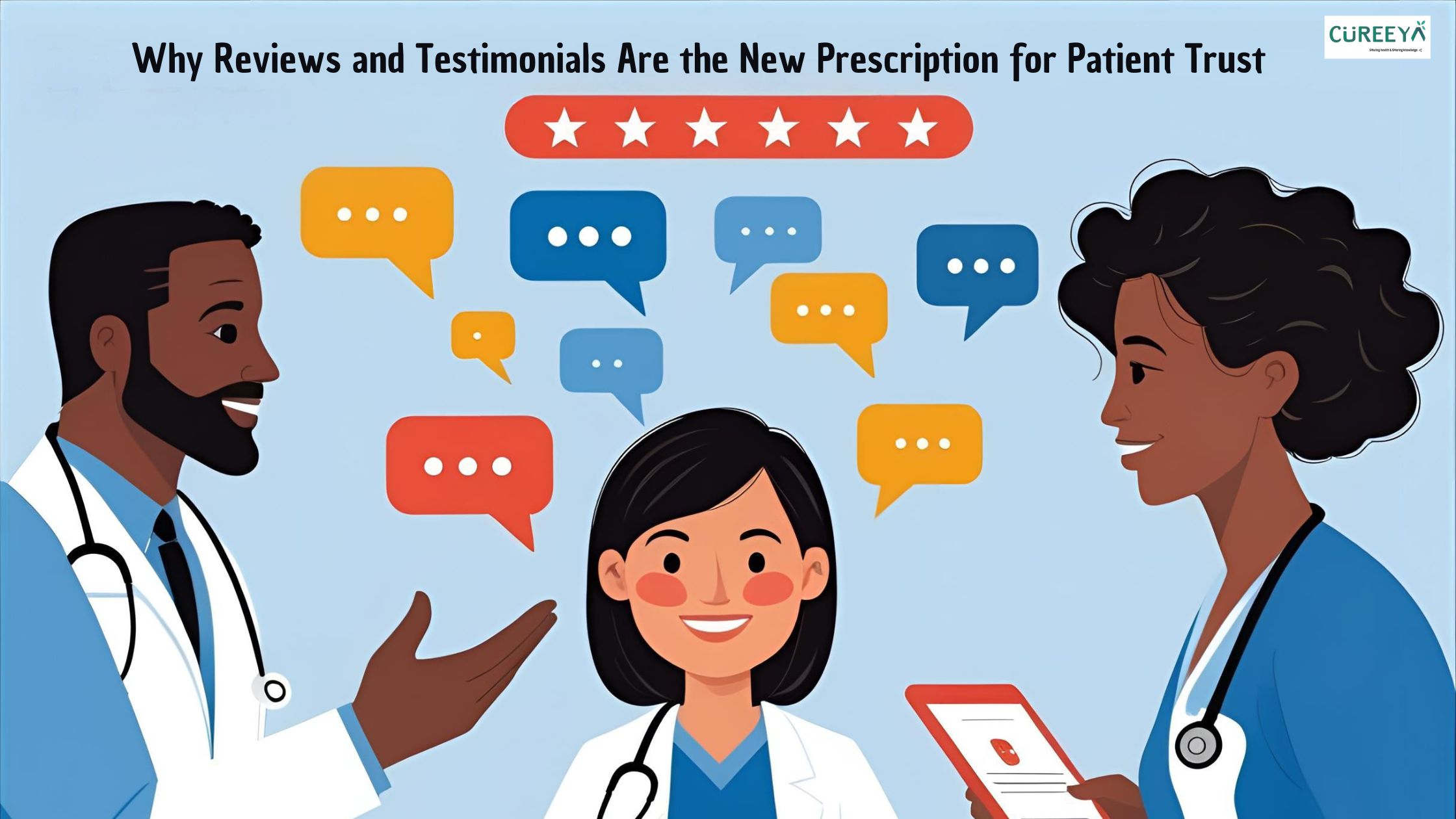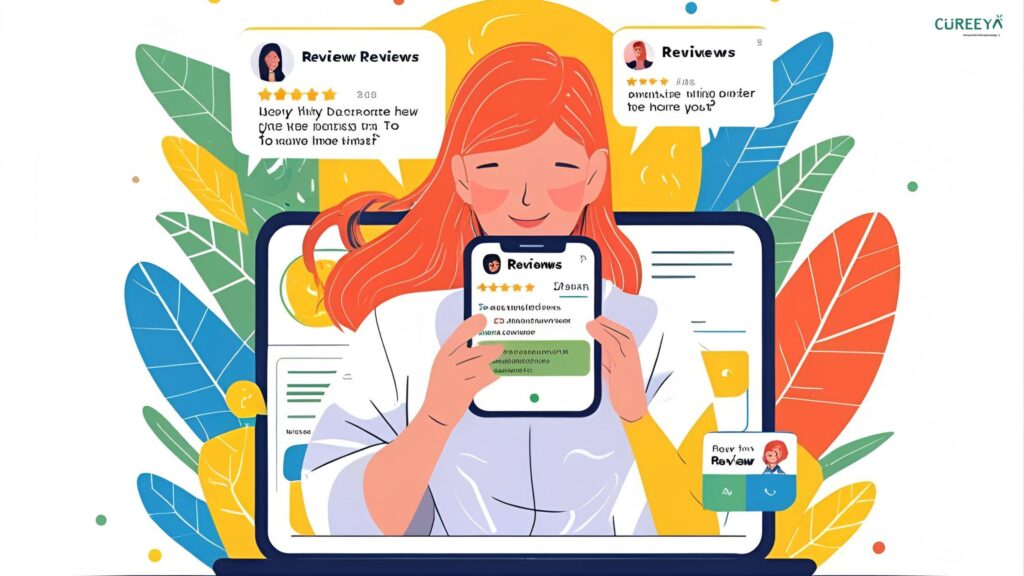
Introduction: A Story Patients Trust
Imagine this:
A young mother in Delhi, anxious about choosing the right pediatrician, isn’t relying on billboards or clinic flyers anymore. Instead, she sits on her couch, opens her phone, and starts scrolling through Google reviews, testimonials on Instagram, and patient stories on YouTube. Within minutes, she makes her decision—not because of the doctor’s years of experience alone, but because other patients vouched for them.
This is the reality of modern healthcare. In today’s digital-first world, reviews and testimonials have become the new prescription for patient trust. They shape first impressions, influence medical choices, and even decide whether a patient books an appointment or keeps searching.
Why Reviews Matter More Than Ever

-
88% of patients trust online reviews as much as personal recommendations (BrightLocal, 2024).
-
81% of patients check reviews before booking a doctor’s appointment (Software Advice, 2023).
-
1 in 3 patients switch providers if their doctor has poor online ratings (Healthgrades, 2022).
These numbers reveal one truth: patients no longer rely only on word-of-mouth offline—digital reputation is equally, if not more, powerful.
Also Read: Top Healthcare Marketing Trends to Watch in 2025: Strategies for Success
The Psychology Behind Patient Trust
Why do reviews and testimonials hold such weight in healthcare?
-
Social Proof: When patients see others share positive stories, they believe the doctor is trustworthy.
-
Risk Reduction: Healthcare choices are life-impacting. Testimonials reduce the “fear of the unknown.”
-
Transparency: Patients value authenticity more than polished ads. Real reviews feel raw and credible.
Think of it this way—when choosing a new phone, we compare specs and reviews. When choosing a doctor, the stakes are higher, so reviews matter 10x more.
Reviews: The New Digital Word-of-Mouth
Earlier, trust was built in neighborhood conversations. Today, it’s built on:
-
Google Business Profile reviews
-
Hospital and clinic websites
-
YouTube patient stories
-
Instagram reels of recovery journeys
For doctors, these platforms aren’t just marketing—they are trust-building ecosystems.
The Hidden Side Most Blogs Don’t Talk About
While many articles talk about “getting more reviews,” few highlight these deeper insights:
1. Negative Reviews Can Build More Trust
Surprisingly, a doctor with only 5-star reviews looks “too perfect” and may raise suspicion. A mix of 4- and 5-star reviews (with honest patient stories) feels more authentic.
2. Video Testimonials Outperform Written Ones
According to Wyzowl (2023), 79% of people say they trust video testimonials more because they can see and hear real patients. Clinics using short testimonial reels on Instagram or YouTube Shorts gain higher patient engagement.
3. Timeliness of Reviews Matters
Patients care about recent experiences. A glowing review from 2019 carries less weight than a fresh review from last week. Doctors should focus on ongoing reputation building, not one-time collection.
4. Specialty-Specific Reviews Drive Conversions
A gynecologist with testimonials on safe pregnancy journeys or an orthopedic with reviews on pain-free recovery builds faster trust because patients see relevance to their needs.
How Reviews Impact SEO and Visibility

Beyond trust, reviews also boost SEO rankings.
-
Google ranks clinics higher with consistent, positive reviews.
-
Reviews improve local SEO, helping doctors appear in “near me” searches.
-
Keywords from patient reviews (like “best dentist in Mumbai” or “painless surgery”) help Google match clinics with patient intent.
This means reviews are not just for credibility—they are a growth engine.
Also Read: Maximizing Your Clinic’s Online Presence with Healthcare SEO
Actionable Strategies for Doctors & Clinics
Here are practical steps to turn reviews into patient trust:
-
Encourage Patients at the Right Time – Ask happy patients to leave reviews immediately after treatment.
-
Make It Simple – Use QR codes, WhatsApp links, or SMS reminders to guide patients directly to review platforms.
-
Respond to Every Review – A polite thank-you to positive reviews and a respectful reply to negative ones shows professionalism.
-
Leverage Video Testimonials – Record short patient stories (with consent) and share them on social media.
-
Highlight Testimonials on Websites – Place them on landing pages, appointment booking sections, and doctor profiles.
-
Monitor Reputation Actively – Use tools like Reputation.com or Birdeye to track and manage reviews.
Real Data Example: Impact of Reviews on Patient Acquisition
-
A dermatology clinic in Bangalore increased new patient bookings by 34% in 3 months after running a review campaign on Google (LocalCase Study, 2023).
-
A cardiologist who posted weekly testimonial reels on Instagram reported 60% more direct appointment inquiries.
-
Hospitals with 4.5+ star ratings receive 2.5x more patient calls than those below 4 stars (Healthgrades, 2022).
Conclusion: Reviews Are the Prescription for Tomorrow’s Healthcare
In the fast-moving world of healthcare, trust is currency. And today, reviews and testimonials are the prescription patients rely on before making decisions.
Doctors and clinics that embrace this shift will not only attract more patients but also build lasting relationships rooted in trust.
Remember: It’s not what you say about yourself, but what patients say about you that matters most.
Key Takeaways (Bullet Points)
-
81% of patients check reviews before booking a doctor.
-
Video testimonials build 79% more trust than text reviews.
-
Recent and specialty-specific reviews influence decisions strongly.
-
Negative reviews, when handled well, can increase trust.
-
Reviews impact SEO rankings and visibility, boosting “near me” searches.
-
Continuous reputation management leads to higher patient acquisition.



